Er is al veel gepubliceerd over dit stukje schaakgeschiedenis: de ivoren schaakstukken die in 1831 werden gevonden op de kust van “the Isle of Lewis” (Schotland).
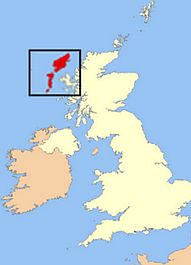
Nog datzelfde jaar werden de 78 schaakstukken in Edinburgh tentoongesteld.
De schaakstukken zijn zeer fraai uit walrus ivoor en walvis tanden gesneden. Uitgebeeld zijn: een koning op zijn troon, een bezorgde of geschrokken koningin, een bisschop of geestelijke, een ridder te paard en staande warders of berzerkers. De pionnen hebben de vorm van kleine obelisken. Momenteel worden ze bewaard en tentoongesteld in de National Museums Scotland en het British Museum.
Het bijzondere aan dezed stukken is niet alleen dat er voor het eerst duidelijke menselijke figuren worden uitgebeeld, maar ook dat een bisschop of geestelijke in het spel voorkwam. Met name dit laatste heeft de discussie over de oorsprong van de stukken doen oplaaien.
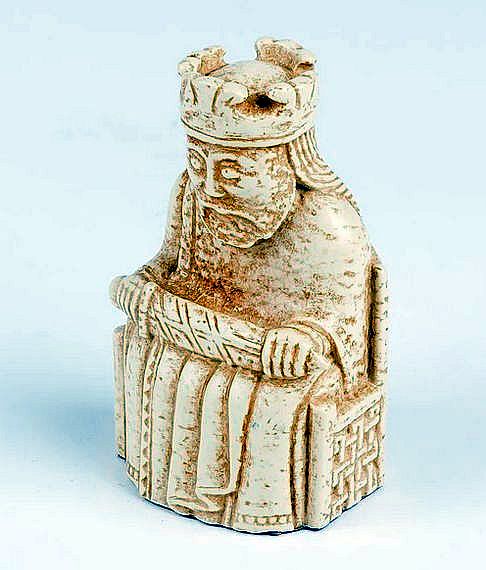
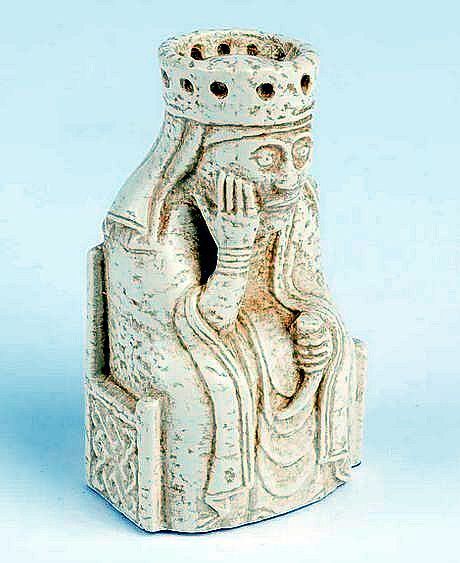
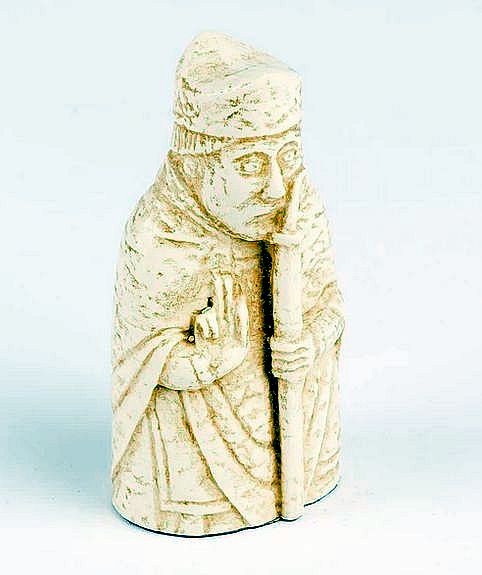

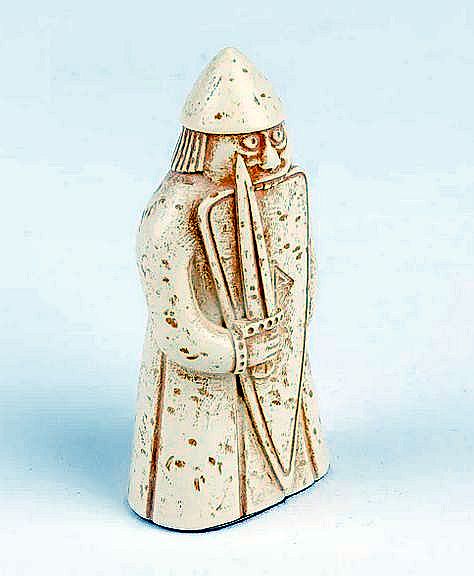
Oorsprong
Het verhaal over de oorsprong van de stukken dat zowel door the British Museum als the National Museums Scotland wordt verteld, is dat de stukken van een koopman waren die van Noorwegen naar Ierland onderweg was. De stukken zouden in de late 12de of de vroege 13de eeuw in Noorwegen zijn gemaakt. Dit heeft men afgeleid uit de detaillering van de mijter die het stuk, dat de bisschop voorstelde, droeg. Dergelijke mijters werden rond 1150 geintroduceerd en rond 1200 kwamen weer andere mijters in de mode.
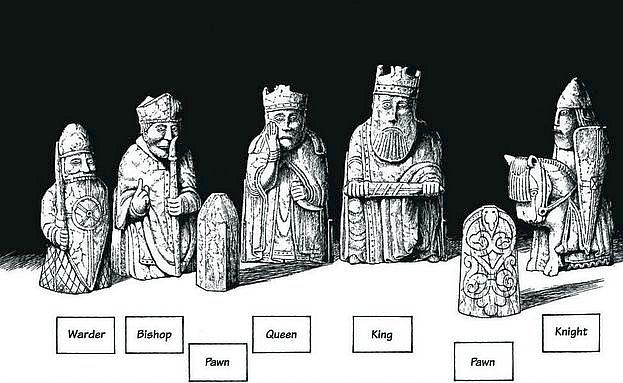
Maar juist het feit dat we het hebben over een bisschopsmijter heeft tot discussie geleid en wel dat de stukken uit IJsland afkomstig zijn. De term “Bisschop” in het schaakspel wordt alleen gehanteerd in de Engelse en IJslandse taal; in de andere Scandinavische talen, het Duits en het Nederlands is het een “Loper” (van het werkwoord lopen).
In de Engelse taal komt het woord “bishop” pas rond 1450 voor?! Van de andere kant: IJsland was in de Midddeleeuwen nog niet veel meer dan een met ijs en sneeuw bedekt land met hier en daar een boerennederzetting, zodat het ongeloofwaardig lijkt dat de verfijnde kunstwerken die de stukken zijn en de kostbare hoeveelheid ivoor die er voor nodig was, toen in IJsland voorhanden was!
Schaakspel of Hnefatfl?
Andere onderzoekers trekken weer in twijfel of de stukken wel voor het schaakspel bedoeld waren. In de Middeleeuwen was een ander bordspel, Hnefatfl, erg populair in de Scandinavische landen. Met de gevonden stukken is het namelijk mogelijk om 3 beginopstellingen van het Hnefatfl spel te vormen.
Verloren stuk gevonden
Een tijdje terug was dit nieuws in een Engelse krant:
“A medieval chess piece that was missing for almost 200 years had been unknowingly kept in a drawer by an Edinburgh family and has been sold at auction for £735,000.
They had no idea that the object was one of the long-lost Lewis Chessmen – which could now fetch £1m at auction. The chessmen were found on the Isle of Lewis in 1831 but the whereabouts of five pieces have remained a mystery.
The Edinburgh family’s grandfather, an antiques dealer, had bought the chess piece for £5 in 1964. He had no idea of the significance of the 8.8cm piece (3.5in), made from walrus ivory, which he passed down to his family.
They have looked after it for 55 years without realising its importance, before taking it to Sotheby’s auction house in London.
The Lewis Chessmen are among the biggest draws at the British Museum and the National Museum of Scotland in Edinburgh. They are seen as an “important symbol of European civilisation” and have also seeped into popular culture, inspiring everything from children’s show Noggin The Nog to part of the plot in Harry Potter And The Philosopher’s Stone.
Sotheby’s expert Alexander Kader, who examined the piece for the family, said his “jaw dropped” when he realised what they had in their possession.
“They brought it in for assessment,” he said. “That happens every day. Our doors are open for free valuations. “We get called down to the counter and have no idea what we are going to see. More often than not, it’s not worth very much. “I said, ‘Oh my goodness, it’s one of the Lewis Chessmen’.”
Mr Kader, Sotheby’s co-worldwide head of European sculpture and works of art, said the family, who want to remain anonymous, were “quite amazed”.
“It’s a little bit bashed up. It has lost its left eye. But that kind of weather-beaten, weary warrior added to its charm,” he said.
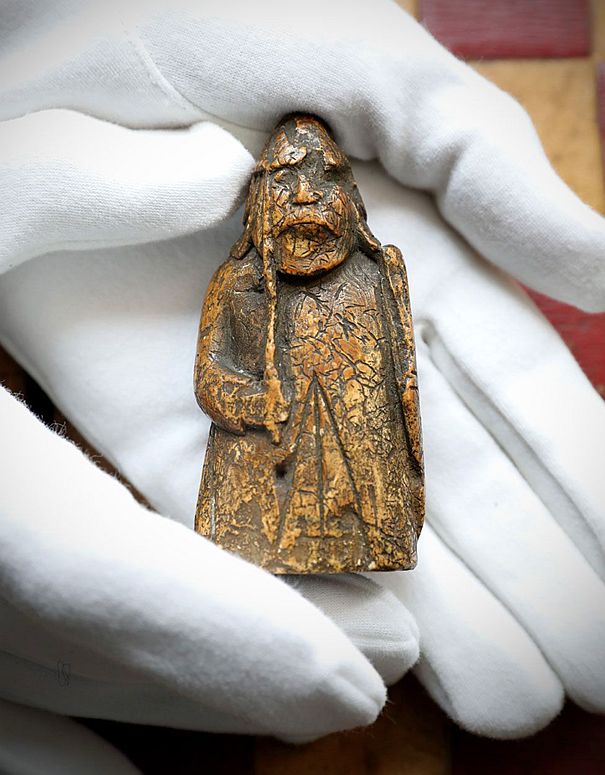
Despite not knowing its significance, the late 12th/early 13th Century chess piece had been “treasured” by the family. The current owner’s late mother believed it “almost had magical qualities”. A family spokesman said in a statement: “My grandfather was an antiques dealer based in Edinburgh, and in 1964 he purchased an ivory chessman from another Edinburgh dealer. “It was catalogued in his purchase ledger that he had bought an ‘Antique Walrus Tusk Warrior Chessman’.”
“From this description it can be assumed that he was unaware he had purchased an important historic artefact. “It was stored away in his home and then when my grandfather died my mother inherited the chess piece. “My mother was very fond of the Chessman as she admired its intricacy and quirkiness. She believed that it was special and thought perhaps it could even have had some magical significance. “For many years it resided in a drawer in her home where it had been carefully wrapped in a small bag. From time to time, she would remove the chess piece from the drawer in order to appreciate its uniqueness.”
The Lewis Chessmen set includes seated kings and queens, bishops, knights and standing warders and pawns. Some 82 pieces are now in the British Museum and 11 pieces held by the National Museum of Scotland. As well as the chess pieces, the hoard includes 14 “tablemen” gaming pieces and a buckle.
Since the hoard was uncovered in 1831, one knight and four warders have been missing from the four combined chess sets.
The newly-discovered piece is a warder, a man with helmet, shield and sword and the equivalent of a rook on a modern chess board, which “has immense character and power”.
The Lewis Chessmen are among the biggest draws at the British Museum and the National Museum of Scotland in Edinburgh.ade in Scandinavia, possibly Norway, they are seen as an “important symbol of European civilisation”.
The newly-discovered piece is a warder, a man with helmet, shield and sword, which “has immense character and power”.
Following the sale, Mr Kader said: “This is one of the most exciting and personal rediscoveries to have been made during my career. “It has been such a privilege to bring this piece of history to auction and it has been amazing having him on view at Sotheby’s over the last week – he has been a huge hit. “When you hold this characterful warder in your hand or see him in the room, he has real presence.” Despite not knowing its significance, the late 12th/early 13th Century chess piece had been “treasured” by the family.
